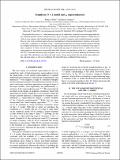Symplectic-N t-J model and s[subscript ±] superconductors
Author(s)
Flint, Rebecca; Coleman, Piers
DownloadFlint-2012-Symplectic-N t-J.pdf (567.2Kb)
PUBLISHER_POLICY
Publisher Policy
Article is made available in accordance with the publisher's policy and may be subject to US copyright law. Please refer to the publisher's site for terms of use.
Terms of use
Metadata
Show full item recordAbstract
The possible discovery of s[subscript ±] superconducting gaps in the moderately correlated iron-based superconductors has raised the question of how to properly treat s[subscript ±] gaps in strongly correlated superconductors. Unlike the case of the d-wave cuprates, the Coulomb repulsion does not vanish by symmetry, and a careful treatment is essential. Thus far, only weak-correlation approaches have included this Coulomb pseudopotential, which has motivated us to introduce a symplectic-N treatment of the t − J model that incorporates the strong Coulomb repulsion through the complete elimination of on-site pairing. Through a proper extension of time-reversal symmetry to the large-N limit, symplectic N allows, for the first time, a superconducting large-N solution of the t − J model. For d-wave superconductors, the previous uncontrolled mean-field solutions are reproduced, while for s[subscript ±] superconductors, the SU(2) constraint enforcing single occupancy acts as a pair chemical potential adjusting the location of the gap nodes. This adjustment can capture the wide variety of gaps proposed for the iron-based superconductors: line and point nodes, as well as two different, but related full gaps on different Fermi surfaces.
Date issued
2012-11Department
Massachusetts Institute of Technology. Department of PhysicsJournal
Physical Review B
Publisher
American Physical Society
Citation
Flint, Rebecca, and Piers Coleman. “Symplectic-N t-J Model and S[subscript ±] Superconductors.” Phys. Rev. B 86, no. 18 (November 2012). © 2012 American Physical Society
Version: Final published version
ISSN
1098-0121
1550-235X